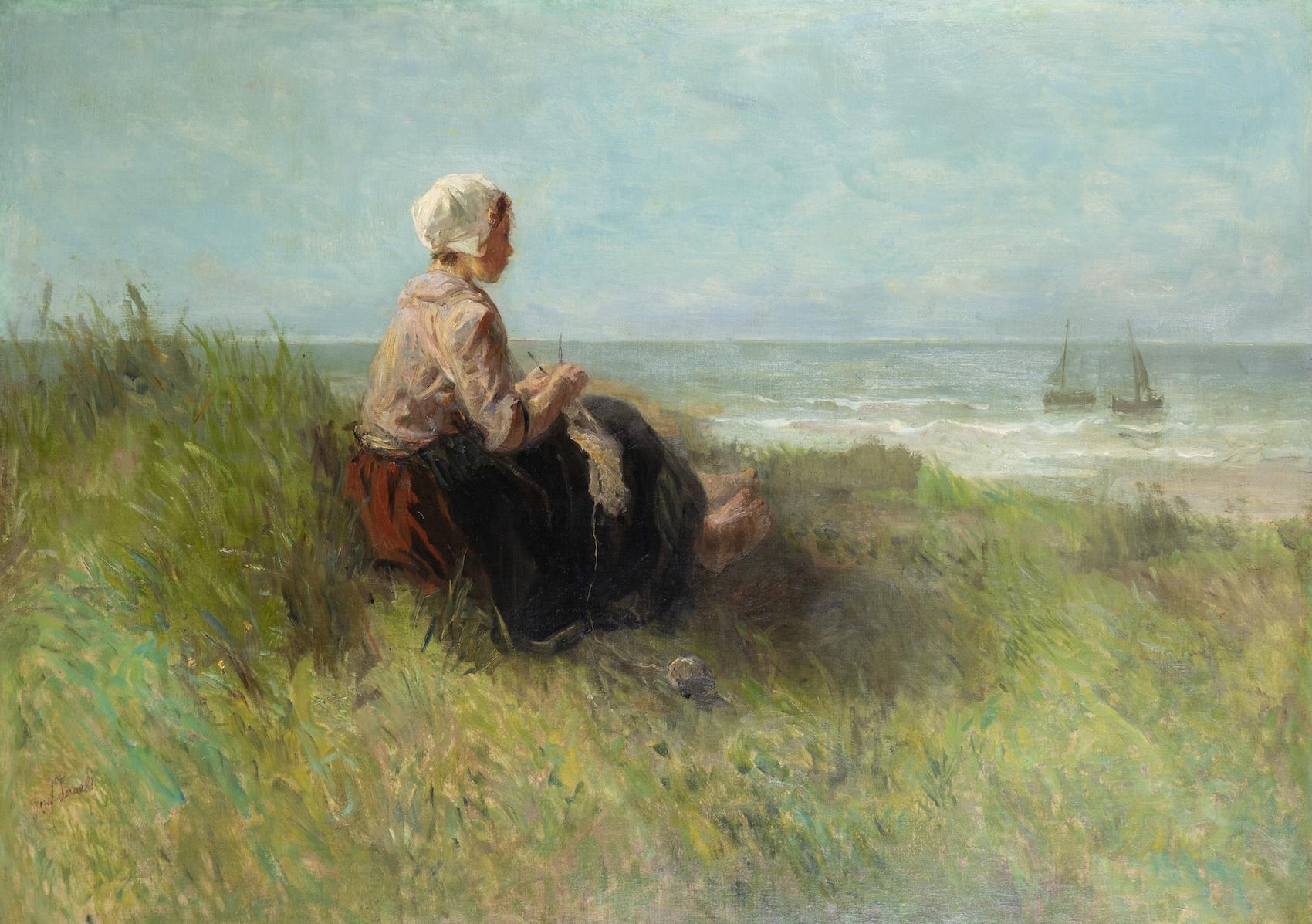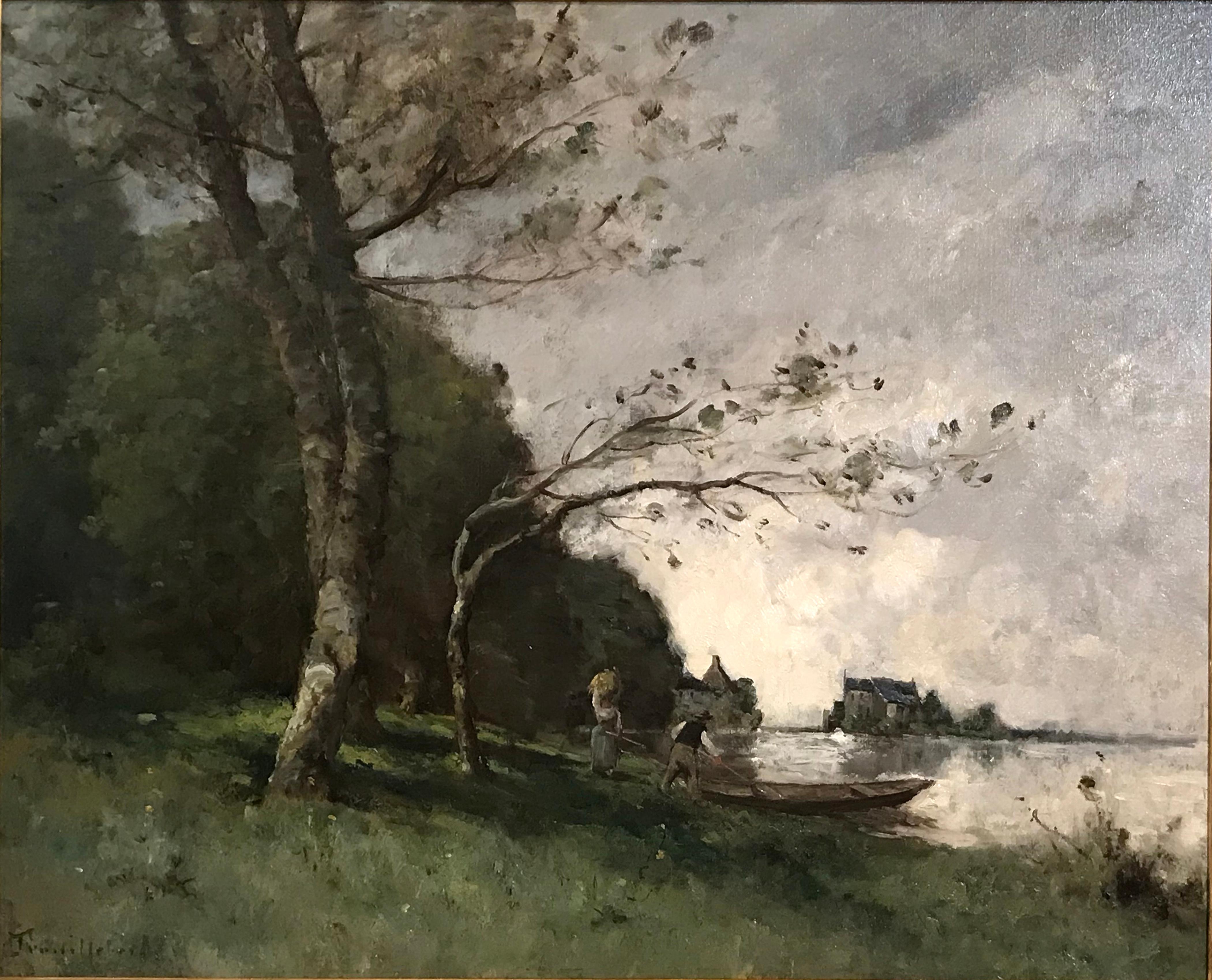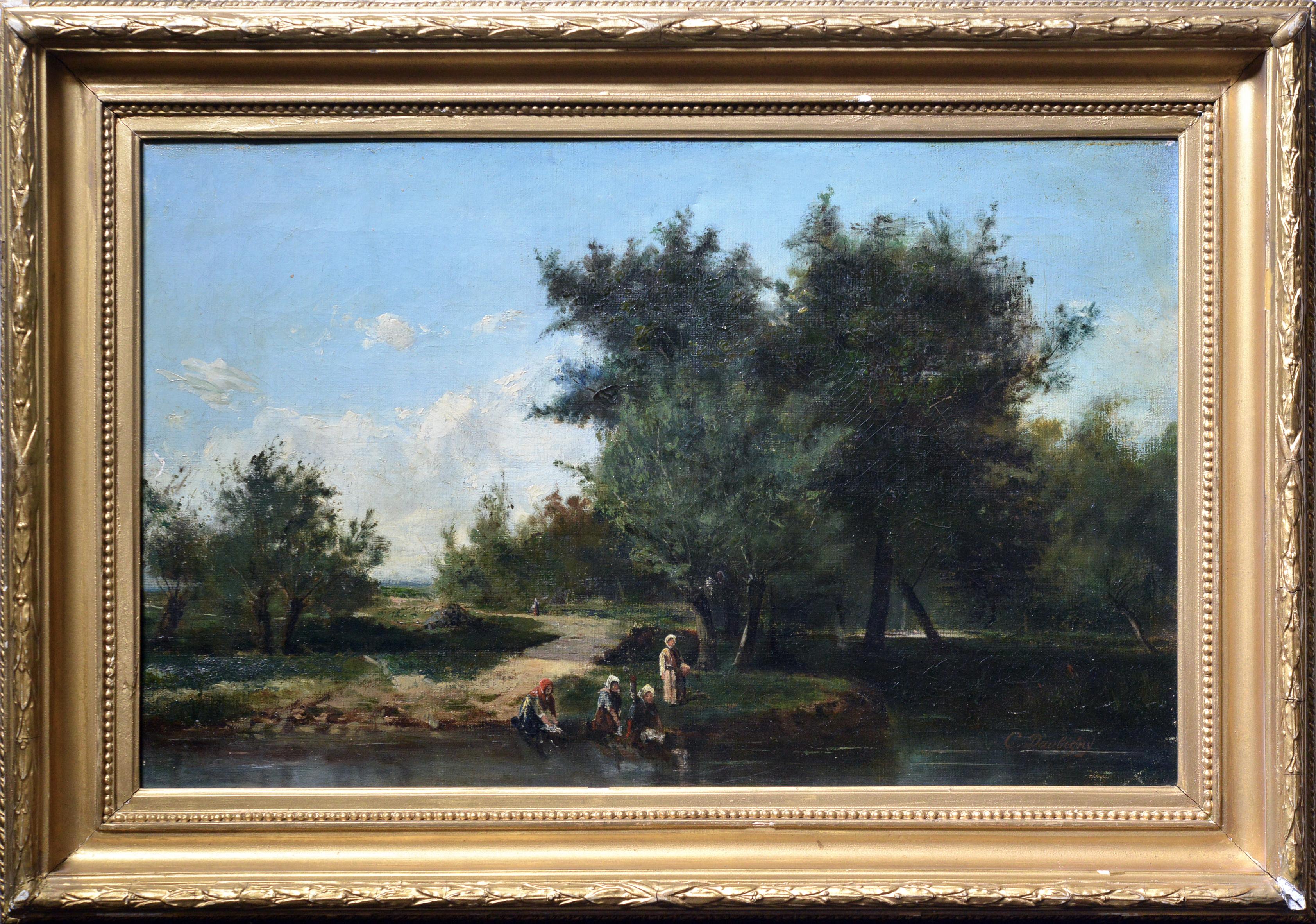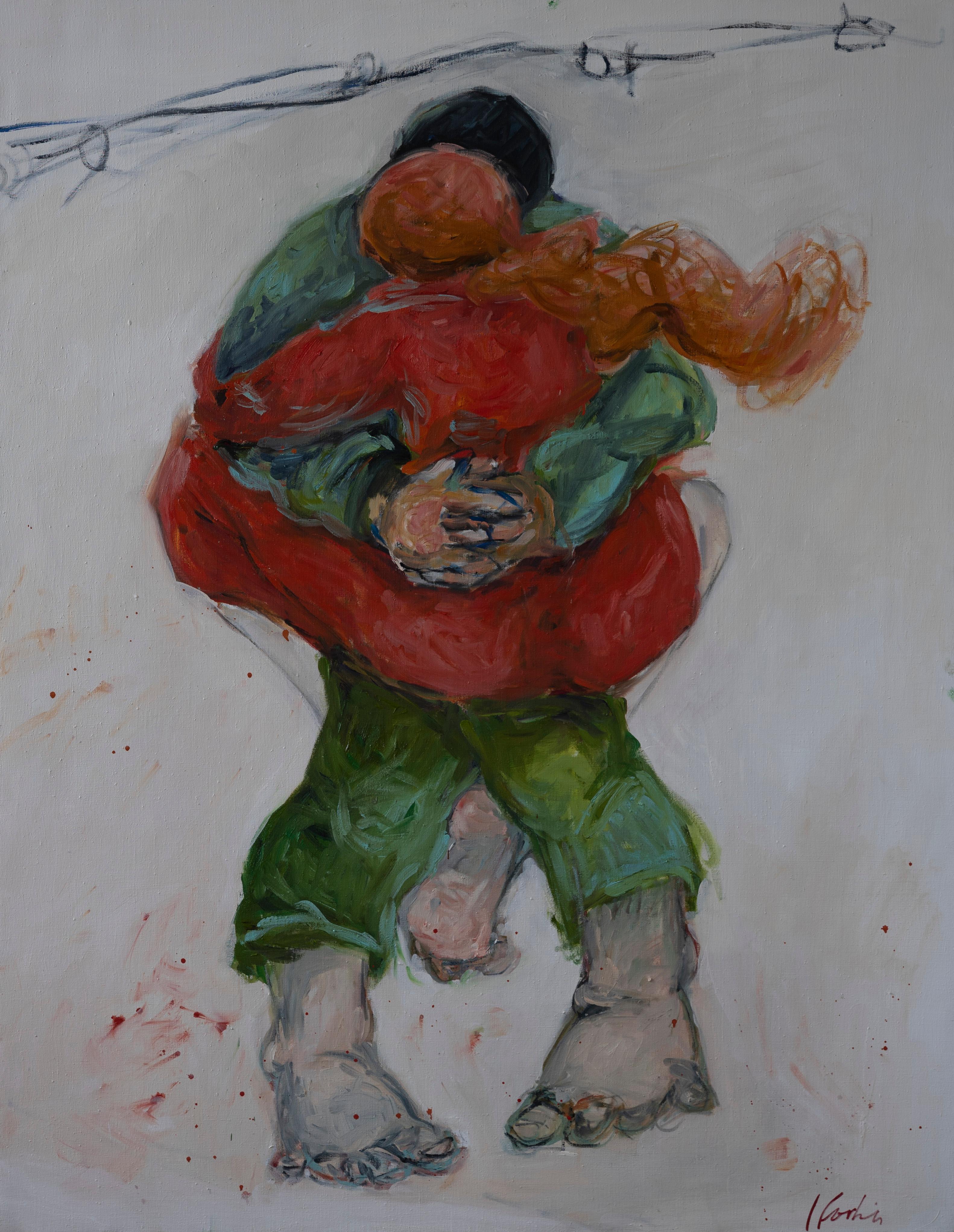Items Similar to The River Bridge, Barbizon School, Circle of Jean Baptiste Camille Corot
Video Loading
Want more images or videos?
Request additional images or videos from the seller
1 of 17
M Legrand de CThe River Bridge, Barbizon School, Circle of Jean Baptiste Camille Corot1860s
1860s
About the Item
A French Barbizon School oil on canvas view of an idylic landscape signed M Legrand de C. Signed bottom left and presented in fine gilt 'Regence' style frame. The painting is on a quality stretcher with 'keys'.
The artist has captured the feeling of a beautiful sunny day in a copse of poplar trees by the side of a river. There is a bridge in the right foreground to traverse the lightly flowing river, the sunshine sparkling on its surface. To the left a stile gate and beyond more trees and the far distance we can just see the flash of red terracotta roof tiles on a farm building.
The artist has used the typical colour palette of the Barbizon school, shades of green and a lovely azure for the sky. The whites adding the highlights and the touch of red catching the eye and bringing the whole composition to life. A really beautiful and accomplished painting.
The Barbizon school of painters were part of an art movement towards Realism in art, which arose in the context of the dominant Romantic Movement of the time. The Barbizon school was active roughly from 1830 through 1870. It takes its name from the village of Barbizon, France, on the edge of the Forest of Fontainebleau, where many of the artists gathered. Most of their works were landscape painting, but several of them also painted landscapes with farmworkers, and genre scenes of village life. Some of the most prominent features of this school are its tonal qualities, colour, loose brushwork, and softness of form.
The leaders of the Barbizon school were: Théodore Rousseau, Charles-François Daubigny, Jules Dupré, Constant Troyon, Charles Jacque, and Narcisse Virgilio Díaz. Jean-François Millet lived in Barbizon from 1849, but his interest in figures with a landscape backdrop sets him rather apart from the others. Jean-Baptiste-Camille Corot was the earliest on the scene, first painting in the forest in 1829, but British art historian Harold Osborne suggested that "his work has a poetic and literary quality which sets him somewhat apart". Other artists associated with the school, often pupils of the main group, include: Henri Harpignies, Albert Charpin, François-Louis Français, and Émile van Marcke.
- Creator:M Legrand de C (French)
- Creation Year:1860s
- Dimensions:Height: 14.75 in (37.47 cm)Width: 17.75 in (45.09 cm)Depth: 1 in (2.54 cm)
- Medium:
- Movement & Style:
- Period:
- Condition:The painting has some areas of expert restoration, see photos. There is also some cracking to the corners of the frame.
- Gallery Location:Cotignac, FR
- Reference Number:
About the Seller
5.0
Platinum Seller
These expertly vetted sellers are 1stDibs' most experienced sellers and are rated highest by our customers.
Established in 2000
1stDibs seller since 2020
165 sales on 1stDibs
Typical response time: 1 hour
- ShippingRetrieving quote...Ships From: Cotignac, France
- Return PolicyA return for this item may be initiated within 3 days of delivery.
More From This SellerView All
- The Forest, Large Barbizon School, Oil on Canvas Wooded LandscapeBy Emile Roux-FabreLocated in Cotignac, FRA French Barbizon School oil on canvas forest view by Emile Roux-Fabre. The painting is signed and dated bottom left with a dedication. A charming view of forest glade leading out to a valley landscape beyond. The artist has captured the magic feeling of the cool forest shade against the sunshine of the landscape beyond. The texture of the bark on the silver birch trees, the contrast of the leaves on the trees all framing the perspective to the view beyond. An extremely accomplished and atmospheric painting. The Barbizon school of painters was part of an art movement towards Realism in art, which arose in the context of the dominant Romantic Movement of the time. The Barbizon school was active roughly from 1830 through 1870. It takes its name from the village of Barbizon, France, on the edge of the Forest of Fontainebleau, where many of the artists gathered. Most of their works were landscape paintings, but several of them also painted landscapes with farmworkers, and genre scenes of village life. Some of the most prominent features of this school are its tonal qualities, colour, loose brushwork, and softness of form. The leaders of the Barbizon school were: Théodore Rousseau, Charles-François Daubigny, Jules Dupré, Constant Troyon, Charles Jacque, and Narcisse Virgilio Díaz. Jean-François Millet lived in Barbizon from 1849, but his interest in figures with a landscape backdrop sets him rather apart from the others. Jean-Baptiste-Camille Corot was the earliest on the scene, first painting in the forest in 1829, but his work has a poetic and literary quality which sets him somewhat apart. Other artists associated with the school, often pupils of the main group, include: Henri Harpignies, Albert Charpin, François-Louis Français and Émile van Marcke. In 1824 the Salon de Paris exhibited works of John Constable, an English painter. His rural scenes influenced some of the younger artists of the time, moving them to abandon formalism and to draw inspiration directly from nature. Natural scenes became the subjects of their paintings rather than mere backdrops to dramatic events. During the Revolutions of 1848 artists gathered at Barbizon to follow Constable's ideas, making nature the subject of their paintings. The French landscape became a major theme of the Barbizon painters. Millet extended the idea from landscape to figures — peasant figures, scenes of peasant life, and work in the fields. In The Gleaners (1857), for example, Millet portrays three peasant women working at the harvest. Gleaners are poor people who are permitted to gather the remains after the owners of the field complete the main harvest. The owners (portrayed as wealthy) and their laborers are seen in the back of the painting. Millet shifted the focus and the subject matter from the rich and prominent to those at the bottom of the social ladders. To emphasize their anonymity and marginalized position, he hid their faces. The women's bowed bodies represent their everyday hard work. In the spring of 1829, Jean-Baptiste-Camille Corot came to Barbizon to paint in the Forest of Fontainebleau, he had first painted in the forest at Chailly in 1822. He returned to Barbizon in the autumn of 1830 and in the summer of 1831, where he made drawings and oil studies, from which he made a painting intended for the Salon of 1830; "View of the Forest of Fontainebleau'" (now in the National Gallery in Washington) and, for the salon of 1831, another "View of the Forest of Fontainebleau"'. While there he met the members of the Barbizon school: Théodore Rousseau, Paul Huet, Constant Troyon, Jean-François Millet, and the young Charles-François Daubigny. During the late 1860s, the Barbizon painters attracted the attention of a younger generation of French artists studying in Paris. Several of those artists visited Fontainebleau Forest to paint the landscape, including Claude Monet, Pierre-Auguste Renoir, Alfred Sisley and Frédéric Bazille. In the 1870s those artists, among others, developed the art movement called Impressionism and practiced 'plein air' painting. In contrast, the main members of the school made drawings and sketches on the spot, but painted back in their studios. The Post-Impressionist painter Vincent Van Gogh studied and copied several of the Barbizon painters as well, including 21 copies of paintings by Millet. He copied Millet more than any other artist. He also did three paintings in Daubigny's Garden. The Barbizon painters also had a profound impact on landscape painting in the United States. This included the development of the American Barbizon school by William Morris Hunt. Several artists who were also in, or contemporary to, the Hudson River School studied Barbizon paintings for their loose brushwork and emotional impact. A notable example is George Inness, who sought to emulate the works of Rousseau. Paintings from the Barbizon school also influenced landscape painting in California. The artist Percy Gray...Category
Early 20th Century Barbizon School Landscape Paintings
MaterialsCanvas, Oil
- Barbizon Period English Landscape, Oil on Canvas, Circle of John ConstableBy Alfred VickersLocated in Cotignac, FRBarbizon Period mid 19th Century oil on canvas English rural landscape by Alfred Vickers, Signed bottom right with old collectors label to the rear stretcher. Presented in fine custo...Category
Mid-19th Century Barbizon School Landscape Paintings
MaterialsCanvas, Oil
- Barbizon School Lakeside Landscape With CastleLocated in Cotignac, FRAn oil on panel idyllic landscape by Boggio. The painting is signed bottom right. An idealised lakeside landscape view with a castle in the distance in the style of the Barbizon sch...Category
Mid-20th Century Barbizon School Landscape Paintings
MaterialsOil, Board
- Barbizon School Lakeside Landscape, The Shady Glen.Located in Cotignac, FRAn oil on panel idyllic landscape by Boggio. The painting is signed bottom right. An idealised lakeside landscape view of a shady glen in the style of the Barbizon school.Category
Mid-20th Century Barbizon School Landscape Paintings
MaterialsOil, Board
- Barbizon Lakeside Landscape With Poplar Trees. Oil on Board.Located in Cotignac, FRAn oil on panel idyllic landscape by Boggio. The painting is signed bottom left. An idealised lakeside landscape view with poplar trees in the style of the Barbizon school.Category
Mid-20th Century Barbizon School Landscape Paintings
MaterialsOil, Board
- Barbizon School Forest LandscapeLocated in Cotignac, FRAn oil on panel idyllic forest landscape by Boggio. The painting is not signed but was acquired from the artists atelier with other works also listed here on 1stDibs. An idealised f...Category
Mid-20th Century Barbizon School Landscape Paintings
MaterialsOil, Board
You May Also Like
- Waiting by Jozef Israëls - Landscape oil paintingBy Jozef IsraëlsLocated in London, GBWaiting by Jozef Israëls (1824-1911) Oil on canvas 95.3 x 133.9 cm (37 ½ x 52 ¾ inches) Signed lower left, Jozef Israels A monumental painting by one of...Category
19th Century Barbizon School Figurative Paintings
MaterialsCanvas, Oil
- Moulin sur la vienne , oil on canvas , signed lower leftBy Paul Desire TrouillebertLocated in Barbizon, FR“Moulin sur la Vienne” Oil on canvas 65.5 x 81.5 cm. Signed lower left Provenance: collection of Monsieur and Madame Baudet, friends of the painter. Exhibition: Salon d'Hiver 1910, ...Category
Late 19th Century Barbizon School Landscape Paintings
MaterialsOil, Canvas
- Laundresses on River 19th century Barbizonian Landscape by French MasterLocated in Stockholm, SESigned lower right "C. Daubigny". As we gaze upon the painting, we are immediately drawn to the foreground, where a small group of women are diligently washing clothes on the banks o...Category
Mid-19th Century Barbizon School Landscape Paintings
MaterialsCanvas, Wood, Cotton Canvas, Oil
- French Contemporary Art by Laurence Forbin - Grande EtreinteBy Laurence ForbinLocated in Paris, IDFOil on canvasCategory
2010s Barbizon School Landscape Paintings
MaterialsCanvas, Oil
- Antique Barbizon School Oil Painting Original Gold Frame Rich Colors FallLocated in Buffalo, NYOriginal Barbizon school painting in an original period frame. Framed 24 x 18 Unframed 18 x 12Category
19th Century Barbizon School Landscape Paintings
MaterialsOil, Canvas
- "Flushing Landscape with Cows, " Charles Henry Miller, Barbizon, Rural FarmBy Charles Henry MillerLocated in New York, NYCharles Henry Miller Flushing Landscape with Cows, circa 1880 Signed lower left Oil on canvas 13 x 19 inches Charles Henry Miller was a noted artist and painter of landscapes from Long Island, New York. The American poet Bayard Taylor called him, "The artistic discoverer of the little continent of Long Island." Miller was educated at Mount Washington Collegiate Institute, and graduated in medicine at the New York Homeopathic Institute in 1864. Before his graduation, he had occasionally painted pictures, and in 1860 he exhibited The Challenge Accepted at the National Academy of Design, in New York City. He lived in Queens at the summer estate, Queenslawn, originally purchased by his parents. He went abroad in 1864 and again in 1867, and was a pupil in the Bavarian Royal Academy at Munich under the instruction of Adolf Lier...Category
1880s Barbizon School Landscape Paintings
MaterialsCanvas, Oil
Recently Viewed
View AllMore Ways To Browse
Antique Key Art
M Charles
Framed Antique Keys
Painting French Bridge
Edge Of The Forest
19th C Landscapes
British School 19th
19th Century British School
Barbizon Oil
Barbizon Oil Painting
French Barbizon
Barbizon School Of Painting
Charles River
Barbizon Frame
French Barbizon Painting
Landscape By Barbizon
French Barbizon School
Antique Backdrop





